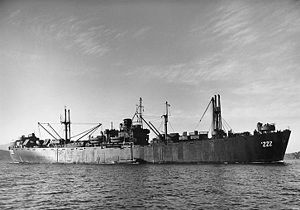USS Livingston (AP-163)
 USS Livingston (AK-222) in San Francisco Bay, California, in late 1945 or early 1946. | |
| Career (USA) | |
|---|---|
| Name: | Livingston |
| Namesake: | A county in Illinois |
| Ordered: | as type (EC2-S-C1) hull, MCE hull 1637 |
| Builder: | California Shipbuilding Corporation, Wilmington, California |
| Laid down: | 22 March 1943, as SS Josiah D. Whitney |
| Launched: | 16 April 1943 |
| Sponsored by: | Mrs. D. W. Fernhout |
| Acquired: | by the U.S. Navy, 25 October 1943 |
| Commissioned: | 10 November 1943 as USS Livingston (AP-163) |
| Decommissioned: | 27 February 1946, at San Francisco, California |
| Reclassified: | Cargo Ship (AK-222), 20 August 1944 |
| Struck: | date unknown |
| Honours and awards: | two battle stars for World War II service |
| Fate: | sold for scrapping, 13 February 1973 |
| General characteristics | |
| Type: | Crater-class cargo ship |
| Tonnage: | 4,023 tons |
| Tons burthen: | 14,250 tons |
| Length: | 441' 6" |
| Beam: | 56' 11" |
| Draft: | 28' 4" |
| Propulsion: | reciprocating steam engine, single propeller, 2,500shp |
| Speed: | 12 knots |
| Complement: | 256 officers and enlisted |
| Armament: | one single 5"/38 dual purpose gun mounts; four single 3"/50 dual purpose gun mounts |
USS Livingston (AP-163/AK-222) was a Crater-class cargo ship built for the U.S. Navy during World War II. She served in the Pacific Ocean theatre of operations, provided valuable services to the U.S. Pacific Fleet, and returned home after the war with two battle stars to her credit.
Contents
Liberty ship built in California
Livingston (AP-163) was laid down as Josiah D. Whitney 22 March 1943 by California Shipbuilding Corporation, Wilmington, California, under a U.S. Maritime Commission contract; launched 16 April 1943; sponsored by Mrs. D. W. Fernhout; acquired by the Navy 25 October 1943; renamed Livingston 30 October 1943; and commissioned 10 November 1943, Lt. Cmdr. Leroy J. Alexanderson in command.
World War II service
After loading cargo, Livingston departed Port Hueneme, California, 22 November 1943 for Pearl Harbor, where she prepared for the Marshall Islands campaign. Departing Pearl Harbor 25 January 1944 with U.S. Marines and Seabees, the transport arrived off Majuro 3 February to reinforce that island. Majuro, with its spacious lagoon, was ideal base for the mobile supply force under Capt. Worral R. Carter. After unloading her cargo, Livingston returned Pearl Harbor 21 February to prepare for the next assignment.
Following another cruise to Majuro in March the transport remained in the Hawaiian Islands, rehearsing with the 27th Infantry Division for the Saipan invasion. Preparations complete, she departed Pearl Harbor 29 May, touched Kwajalein briefly, and arrived off Saipan 20 June. Needed “to secure control of sea communications through the central Pacific,” Saipan was the scene of a bitter battle in which 24,000 Japanese lost their lives futilely attempting to stop the American offensive. Livingston remained off Saipan supporting the fighters ashore until she sailed for Eniwetok 2 July.
Throughout the summer, she transported troops and equipment among the Allied-occupied islands in the Marshall Islands, the Gilbert Islands, and the Mariana Islands. Reclassified AK-222 on 20 August, she returned to Pearl Harbor 6 days later for additional supplies. Livingston returned to the advance bases 30 September, arriving at Eniwetok. For the next 4 months, she made cargo runs to the occupied islands before departing Saipan 26 January 1945 for San Francisco, California.
Following a stateside overhaul, the cargo ship resumed operations in mid-April. After a round-trip cruise to Pearl Harbor, she sailed again from San Francisco, California, 15 May for Tarawa, Gilbert Islands. From arrival 12 June, she continued servicing American island forces in Micronesia throughout the rest of the war. Remaining in the western Pacific Ocean after the Japanese surrender, Livingston shuttled troops and cargo among the islands until late November. Departing Manus on the 29th, she arrived Seattle, Washington, 19 December.
Post-war decommissioning
On 6 January 1946 the cargo ship arrived San Francisco where she decommissioned 27 February and was returned to the War Shipping Administration (WSA) the same day. She entered the National Defense Reserve Fleet and was berthed at Suisun Bay, California until sold for scrapping on 13 February 1973, physically departing the reserve fleet on 27 March 1973.
Honors and awards
Livingston received two battle stars for World War II service:
- Marshall Islands operation - Occupation of Kwajalein and Majuro Atolls, 3 February 1944
- Marianas operation - Capture and occupation of Saipan, 20 June to 2 July 1944
Qualified Livingston personnel were eligible for the following:
See also
References
- This article includes text from the public domain Dictionary of American Naval Fighting Ships. The entry can be found here.
- NavSource Online: Service Ship Photo Archive - AP-163 / AK-222 Livingston
- USS Livingston (AP-163, later AK-222), 1943-1973
- Pages with broken file links
- Wikipedia articles incorporating text from the Dictionary of American Naval Fighting Ships
- Crater class cargo ships
- Liberty ships
- World War II auxiliary ships of the United States
- Transports of the United States Navy
- Ammunition ships of the United States Navy
- United States Navy Illinois-related ships
- Ships built in Los Angeles, California
- 1943 ships
